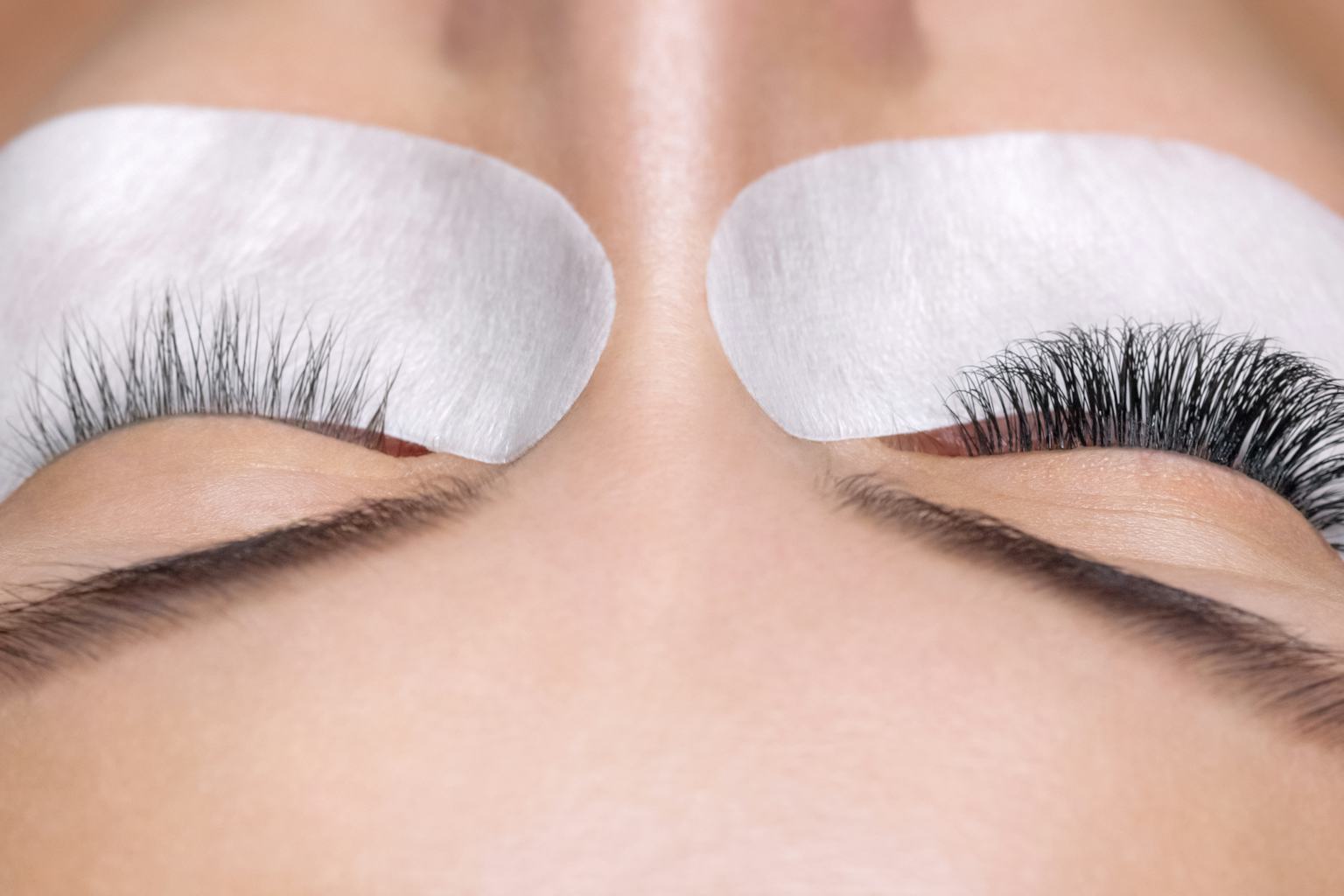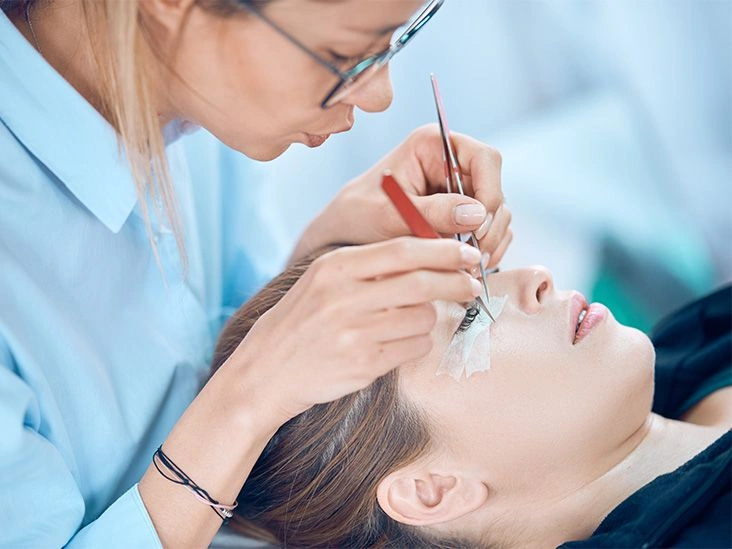Eyelash extensions offer a semi-permanent way to achieve a made-up lash look without relying on mascara.
When applied correctly by a licensed, trained professional, extensions are a generally safe method to boost the appearance of natural lashes.
However, if applied improperly or with the wrong adhesive, they can lead to discomfort, infections, and even permanent lash loss.
Unlike temporary strip false eyelashes that adhere to the eyelid in a single band, eyelash extensions are individual fibers. Each extension is attached to a single natural lash, one by one, and the full application can take several hours to complete.
Extensions are intended to last through the normal growth cycle of your natural eyelashes, roughly six weeks to two months. During that time, upkeep is necessary to keep them looking polished and natural.
Extensions are produced from various materials, including synthetic options like faux mink or plastic fibers, as well as natural choices such as silk or real mink.
Regardless of the fiber, extensions should be bonded with a nonirritating, water-resistant eyelash or surgical adhesive made to tolerate sweat and oils.
Medical-grade adhesives may be preferable because many are low- or no-fume and tend to be less irritating for most skin types.
What are the risks of getting eyelash extensions?
risks of eyelash extensionsAs noted by the American Academy of Ophthalmology, the primary risks tied to eyelash extensions include:
- swelling
- temporary or permanent loss of eyelashes
- irritation of the eyelid skin
- infection of the eyelid or cornea
Most problems arise from a skin reaction or allergy to chemicals in the glue, though unsanitary conditions can also produce complications.

Possible symptoms include:
- stinging or burning in the eye and on the eyelid
- marked swelling
- red or bloodshot eyes
- itching
- pain
- rash
Unless you have a medical condition that makes extensions unsuitable, you can typically reduce these risks by observing these precautions:
- Have a certified cosmetologist or trained aesthetician apply your extensions in a sanitary setting.
- Request a list of ingredients in the adhesive. Avoid any glue containing formaldehyde, a substance known to provoke allergic responses and skin irritation.
- If you have a latex allergy, confirm the adhesive does not contain latex.
- Ensure your technician uses surgical-grade glue rather than nail glue — the latter is a major warning sign.
- Verify that the clinician washes their hands, sterilizes tools, and provides clean linens or towels for you to recline on.
- If you have sensitive skin or known product allergies, ask for a patch test on your arm a few days before the appointment.
Certain skin disorders may make eyelash extensions inadvisable unless your physician approves the procedure in advance.
reasons to avoid eyelash extensionsTalk with your doctor before getting extensions if you have:
- eyelid dermatitis
- blepharitis
- alopecia areata
- trichotillomania
Avoid having extensions while undergoing ocular procedures like LASIK or during treatments such as chemotherapy or radiation.
Benefits of eyelash extensions
Because they remove the need for daily mascara, eyelash extensions can save you time when applying and removing makeup.
If you often use strip false lashes, extensions save even more effort and spare you the hassle of handling glue or dealing with lashes that fall off too soon.
Extensions also offer customization: you can pick length, curl type, and thickness to achieve the look you want.
How much do eyelash extensions cost?
Price varies depending on your location and the materials used; mink fibers typically command higher prices.
On average, having eyelash extensions applied ranges roughly from $125 to $300 or more. Regular touch-ups or fills often run about $50 to $100 per visit.
How are eyelash extensions applied?
Application generally takes about two hours and is performed in a comfortable setting where you’ll either sit or recline.
Some salons play soft music to help clients relax; if yours doesn’t, you might want to listen to music or a podcast during the appointment.
Typical steps in the procedure include:
- The clinician gently cleans both eyes.
- To prevent the lower lashes from sticking to the upper ones, the technician tapes the lower lashes down with surgical tape.
- Individual natural lashes are isolated, usually with tweezers or a specialized tool.
- A single artificial lash is attached to the isolated natural lash using a tiny dab of adhesive.
- This is repeated across the entire upper lid on both eyes.
- Your eyes must remain closed during the process.
Who can apply them?
Extensions should be applied only by certified lash technicians trained specifically for this service. These professionals might be medical personnel, lash stylists, aestheticians, or cosmetologists.
In the U.S., regulations for salons that provide lash extensions vary by state. Check your state’s website to learn any applicable rules governing technicians and salons.
Read client reviews before booking. Choose a reputable spa or clinic known for cleanliness and safety.
When scheduling, ask questions about the adhesive ingredients and whether instruments are sterilized.
Stay in control during the appointment. If the salon seems unclean or the technician won’t answer your questions, stop the service. Do the same if you feel physically or emotionally uncomfortable while your lashes are being applied.
Remember that an unusually low price may indicate compromised hygiene, lack of proper licensure, poor-quality products, or inexperience. This isn’t just about appearance — it’s about protecting your eyes.
How are eyelash extensions removed?
Extensions will fall out naturally over time. If you prefer removal, a professional should do it; the technician who applied them usually offers removal for a fee.
Typical removal steps are:
- The technician covers the upper and lower eyelids and applies a lash adhesive remover, leaving it on for several minutes.
- They then remove the extensions individually with sterilized tweezers, a small brush, or another tool.
Be aware that some removers contain chemicals that can trigger allergies or irritate the skin. Ask for an ingredient list and avoid removers that include formaldehyde.
You can attempt removal at home by steaming your face or applying a warm compress to loosen the glue, then using olive or sesame oil on a cotton swab to gently ease the extensions off. Take care to remove only the artificial lashes and not your natural ones.
The takeaway
Semi-permanent eyelash extensions remove the need for mascara.
They require upkeep and can be costly.
To reduce the chance of complications like infection, have a licensed lash professional perform the application in a clean environment.


















Leave a Reply
You must be logged in to post a comment.